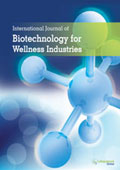|
|
Abstract: Studies were undertaken to isolate, identify and evaluate the biological activities of endophytic mycoflora of Indian medicinal plant, Terminalia arjuna. A total of 20 isolates of endophytic fungi were obtained from the leaves, twigs and bark tissues of the Terminalia arjuna. Out of 20, six isolates exhibited promising antibacterial, antifungal and anti-inflammatory activities when cultivated at shake flask level. The selected isolates were identified on the basis of morphology and ITS gene sequencing. Three isolates, designated as TA BA 1, TA L1 and TA L2 were identified as Aspergillus flavus whereas; the remaining three endophytic fungi were identified as Diaporthe arengae (TA TW2), Alternaria Sp. (TA TW1) and Lasiodiplodia theobromae (TA BA2). Aspergillus flavus was found as the predominant endophyte in leaves and bark tissues of the plant. The crude extract of the test isolates showed considerable antimicrobial activity against common human bacterial (Staphylococcus aureus, Escherichia coli, Pseudomonas aeruginosa, Proteus vulgaris, Salmonella abony and Bacillus subtilis) and fungal (Candida albicans, Aspergillus niger and Penicilium sp.) pathogens. The extract of Diaporthe arengae (TA TW2) significantly reduced the concentration of DPPH free radical as percent DPPH scavenging activity was found to be highest (69.56%) in comparison with other isolates. The % inhibition of hemolysis of RBCs was found to be highest (82.85%) with Diaporthe arengae (TA TW2) in comparison (83.26%) with standard drug (Ibuprofen). Among all, the extract of the Diaporthe arengae (TA TW2) showed excellent biological activities and hence was subjected to further characterization. The phytochemical investigation of the extract revealed the presence of terpenoids as the major phytoconstituents which was supported by TLC and UV spectroscopic studies. The results indicate that the isolated endophytes could be the valuable source of these bioactive molecules with diverse biological activities. The bioactivities may be attributed to the terpenoids present in the endophytic extract. Keywords: Endophytic fungi, Aspergillus flavus, anti-inflammatory, ITS, terpenoids, antimicrobial activity.Download Full Article |






